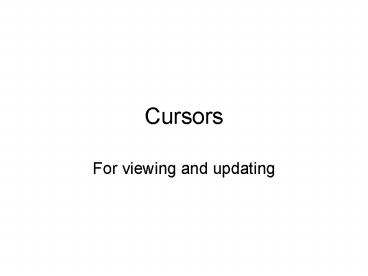Cursors - PowerPoint PPT Presentation
1 / 15
Title: Cursors
1
Cursors
- For viewing and updating
2
Cursors
- How to step through the returned set of rows
3
Selected set
- When a Select statement is issued, the returned
set is a set of rows. - To step through, or process the rows in the set,
it is necessary to be able to look at each one in
turn. - A CURSOR allows the user to iterate through the
returned set.
4
Managing explicit cursors
- The cursor can be declared in any part of a
PL/SQL block, subprogram or package. - Within the program body, the cursor can be
OPENed, FETCHed and CLOSEd. - A cursor cannot be assigned a value or set of
values it must get its contents from a select
statement.
5
Declaring a cursor
- CURSOR cursor_name (parameter, parameter)
- RETURN return_type IS select_statement
- Where
- return_type is a record or row in a database
table - Parameter is defined as
- cursor_parameter)name IN datatype
DEFAULT expression
6
Example cursor declaration
- DECLARE
- CURSOR lateOrd IS
- SELECT supplierorderno, (delivereddate
supplierOrderDate) from sorder where
(delivereddate supplierOrderDate) gt 5 or
delivereddate is null - This cursor will contain a set of rows of
supplier orders that either took more than 5 days
to deliver, or have not been delivered. - The scope of the cursor is the scope of the block
in which it is declared.
7
Declaring the cursor with parameters
- DECLARE
- nodays integer
- CURSOR lateOrd IS
- SELECT supplierorderno, (delivereddate
supplierOrderDate) from sorder where
(delivereddate supplierOrderDate) gt nodays or
delivereddate is null
8
Opening and closing the cursor
- DECLARE
- CURSOR lateOrd IS SELECT
- BEGIN
- OPEN lateOrd
- CLOSE lateOrd
- END
- This opens the cursor, but doesnt fill it.
- If it is a parameterised cursor, it could be
- OPEN lateOrd(3)
9
Fetching the cursor
- DECLARE
- CURSOR lateOrd IS
- SELECT
- supplierorderno, (delivereddate -
supplierOrderDate) - from sorder
- where (delivereddate - supplierOrderDate) gt 5
- or delivereddate is null
- LocOrdNo sOrder.SupplierORDERNOType
- DaysLate Integer
- BEGIN
- OPEN lateOrd
- LOOP
- FETCH lateOrd into LocOrdNo, DaysLate
- EXIT WHEN lateOrdNOTFOUND
- dbms_output.put_line
- ('Order number 'LocOrdNo' was delivered
'DaysLate' days late.') - End Loop
- Close LateOrd
- END
10
Fetching
- Fetch retrieves the rows one at a time from the
result set. - The named exceptions relating to cursors are
- found, notfound, rowcount and isopen.
- These do not automatically raise an exception, so
you must test for them.
11
Cursor loop
- Open LateOrd
- LOOP
- FETCH lateOrd INTO LocOrdNo,
- DaysLate
- dbms_output.put_line (lateOrdrowcount.
Order number LocOrdNo was DaysLate
days late.) - END LOOP
- Dbms_output.put_line (Altogether, there were
LateOrdrowcount late orders) - Close LateOrd
- This numbers the late orders.
12
Other Cursor qualities
- The implicit For loop can open the cursor, fetch
each item individually and then close it (see
next slide). - Instead of having to itemise the columns in the
table, we can declare a cursor row type - Declare
- cursor s1 is
- s1_rec s1rowtype
13
Updating in a shared database
- Selecting places no lock on a row.
- To lock a row, select it with a row share lock,
and then update it. - A row share lock allows others to
- Read the locked row, but only return the
pre-locked state - Read any other row
- Lock any other row.
14
Row-share lock
- A row-share lock allows for
- Read consistency.
- The session placing the lock may update the
locked row. - N.B. The session placing the lock MUST RELEASE
the lock. - This is done by COMMIT or ROLLBACK.
15
Cursors for update
- I want to up the cost price of all stock items
that are supplied by supplier number 101 by 10. - Declare
- cursor s1 is
- select from stock where supplier_Id 501
for update - s1_rec s1rowtype
- Begin
- for s1_rec in s1 loop
- update stock
- set unitcostprice unitcostprice 1.1
- where current of s1
- end loop
- commit
- End































